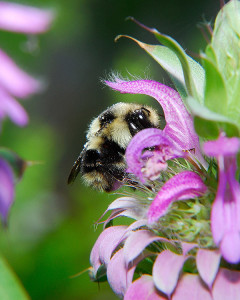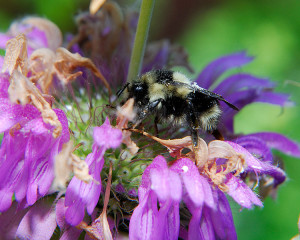We’ve mostly focused on installing the orchard and vegetable gardens this year, but our gardens would only be marginally productive without some help from our resident pollinators.
Some estimates suggest that bumble bees are believed to be responsible for the pollination of approximately 25% of crops in northern California. Even after we add honeybees to the farm next spring, it will still be critical to encourage and support our native bee populations to help ensure that our gardens thrive year-round [1].
In early spring we were delighted to see hoards of native yellow-faced bumble bees (Bombus vosnesenskii) lurking in the lavender, and recently we sighted some native sweat bees on the Verbena and heirloom sunflowers in the gardens.
However, over the weekend we found this large and beautiful bumble bee lazily meandering around the Dotted Mint (Monarda lambada) in the herb garden, and thankfully she didn’t seem to mind the camera’s lens in the least.
After some sleuthing, this female worker appears to be the edwardsii subspecies of Bombus melanopygus, also known as the Black-tip Bumble Bee [2,3]. She was a large bee, and not particularly fast moving.
Identifying her was a little challenging, but one distinguishing feature for this species is the black band running from side to side on the thorax, which is surrounded by yellow hairs.

Bombus melanopygus edwardsii has a black band, surrounded by yellow, on the thorax (ignore the pollen smudge running through the band)
The face of Bombus melanopygus edwardsii is light in coloration, similar to the yellow-faced bumble bee.
The abdomen is divided into 6 (female) or 7 (male) segments, called ‘terga’. Tergites 2 and 3 provide important clues for identifying this subspecies, which are rufous red in the species B. melanopygus, but black in the subspecies B. melanopygus edwardsii.
In addition to these black hairs, B. melanopygus edwardsii has thick yellow hairs on tergites 4 and 5, with a black tail tip.
Although the yellow-faced bumble bees seem to be the most prevalent here, we do occasionally see other species, but this is the first time we’ve been close enough with the camera to identify one of the other Bombus species lurking among our flowers.
Bombus melanopygus edwardsii is native to western North America. This subspecies reportedly nests both above ground, occasionally using old bird nests, and underground in small hollows and rodent burrows, and with an abundance of both on the property, we hope they find some suitable nesting habitat here.
Honeybees usually come to mind as the most prevalent pollinators in most gardens, and as such many native pollinators are frequently overlooked. We’re now making an effort to pay closer attention to both the prevalence and diversity of our native pollinators here, and hope, through continued plantings of various native plant species over time, to encourage many more of our native bee species to visit our gardens. I wonder who we’ll see next?
——————
[1] Native Bees are a Rich Natural Resource in Urban California Gardens (PDF)
[2] Guide to the Bombus of San Francisco (PDF)
[3] Discover Life Online Key to Bumble Bee Species


















Dear Clare like you I am fascinated by theses little creatures especially the wild bombus species.
I have had great difficulty getting the exact ID’s to the little bombus that I photograph so I know to the extent you have carried out your sleuthing to find their individual characteristics and name them correctly.
I found that many of the little bombus were very amicable towards me and were very mild mannered aswell.
Your photos are superb and I really do hope you take up some beekeeping next year as its something I would love to partake in only the deeds of our house don’t allow beekeeping!
It is difficult identifying some of these bees, and some require a microscope to be sure. This species though is apparently well known, at least to those in the know, in this area.
The beekeeping is coming to Curbstone Valley. We’ve been attending area Bee Guild meetings for the last 3 months, and now starting to put together our list of equipment and browsing various beekeeping catalogs. We’ll get the hives set up and painted over winter, so everything will be ready by the end of March – early April. Can’t wait!
Hi CV,
I’m thrilled to see your Bee photos, I too love my pollinators and try to attract as many into the garden as possible.
For me a garden just isn’t complete without having the insects flying or fluttering around. I know many people hate having Bees and such near them, for me it is a delight and I look forward to their return in Spring.
Perhaps I ought to follow your example and keep a more thorough log of which Bees visit…
I think it’s fun to keep track of who is visiting the gardens. I’m curious to see, as we add more natives, and other flowering plants, how our insect populations change over time here.
These photographs are gorgeous! I am amazed at your ability to capture them with the camera, as well as identify them properly. I have many bee species here in my garden, and the sweat bee is the only I can identify, as it looks quite unique.
Your photos are gorgeous, as always. And I love that you take the time and hard work to identify the species – that information combined with your excellent pictures makes for a really, really good resource.
If you were never a teacher, you should have been. Your photos are so clear and the writing so informative. I love stopping in for each post. Something new, always to learn. I like bees and have seen so many different ones in my yard, but never could have identified them as you have done.
I have taught at various points in my career, and I have to say, I genuinely enjoy it. I’ve always been of the opinion that there’s no point stuffing your head full of knowledge, if you don’t pass it on! I’m not teaching at the moment though, well, just myself, as I’m trying to learn as much about our little corner of the world as I can! 🙂
Clare, A marvelous post on your newest garden helper! I love Bumbles! I love to see them working in the garden and I love their furry little bodies covered with pollen. It’s going to be exciting to hear about your adventures with honeybees! gail
I’m sure once we have honeybees…as we’ve never had them before, that we’ll have no shortage of things to blog about 😛
Thank you for the crash bee course, Clare … I have so much to learn! Again, you have taught me something new … I like that 🙂
When it comes to bees, I have so much to learn too! 😉
Great photos! I love native pollinators and I am fascinated by the close relationships that exist between some of our endemics and our native bees, such as Thermopsis macrophylla and bumblebees and carpenter bees.
I’m wondering if you know Val at the blog ‘Pencil and Leaf’. She has made a special study of bees and recently had an exhibition in London of her drawings of bees. She may well be able to confirm your identification.
Lucy
Thanks Lucy, I do know of Val’s blog, and have been reading it for some time now. She’s in the UK though, and probably not as familiar with some of our local bees in California. Fortunately, we do have some local resources who are much more well versed in our bees than me! 😀
Fantastic shots, Clare! Bombus is such a gorgeous creature … and you managed to show it in your photos. I so enjoyed learning about this lovely pollinator.
Around here the bees don’t really need to be encouraged … they swarm in when the gums are in flower. You can hear the drone of the bees all day sometimes during the flowering season out in the bushland.
Bumble bees always make me smile, every tim I see them.
Gorgeous photos and text Clare! You have some busy garden workers there. I often say to myself i should post about our native pollinators. We need all of our bees to help our habitats. I am so grateful for my wild honeybees but appreciate all the native bees too. As so often your posts inspire me! ;>)
Bumble bees are prevalent in my garden and are my favorite. I have never identified the species, however. Your post is inspirational. I will have to do some research to learn more about them.
What a darling! I always wonder if you take the photos and then ID later or stumble around like I do, excitedly balancing my ID book and camera, trying to follow the buzzing wonder around like a crazy lady.
If I’m honest, my geek brain, that needs to know exactly what I’m looking at, has changed the way I use my camera. Now, I see a plant, a bee, anything of interest, I’ve now learned to take photographs, while the opportunity presents itself, of every imaginable perspective. Top of a blossom or leaf might be interesting, but underneath might reveal what I need to know to make a positive ID. Same with bees. Pardon me…shoot the top…the bottom…the middle…and everything in between, and maybe I’ll have what I need 😉
Pollinators are gardeners’ partners in food production. Albert Einstein (allegedly) calculated that if something eliminated the bees from planet earth that mankind will soon perish. Indeed!
Every effort counts in encouraging the pollinators to stay around our gardens. I noticed that the Greek Oregano that I deliberately allowed to flower has been a haven for all the bees from April until now. This was one of my experiments this year.
I might refer to your post when it’s time for me to put a name onto those bees that I see in my garden. 🙂
Hi Clare, I loved this post. I’ve made some attempts in my garden to attract both bumble bees and other wild bees, but the bumble bees haven’t accepted the offered dwellings yet. At this late point in the year, however, it is honeybees that dominate the flowers in our garden. Beautiful photos and research on species!
I’m also inspired – There’s one distinct species in particular that I see around our place, and I haven’t tried to ID it yet. I don’t think I’ve seen the bee you were writing about though – but I’ll keep my eyes open!
It is always a pleasure to return here and get another lesson in the flora and fauna populating your farm. Thank you so much for these descriptions of bees. I too enjoy the bumble bee, especially. Btw, I tagged you as one of my favorite bloggers in a recent post. I hope you don’t mind, and that you might respond with tags of your own. Mostly, I hope a few new readers find their way to your site as a result.
Dear Clare, I believe that there is a lot involved in keeping a healthy hive of bees, but I always delight in seeing them in the garden. In recent years, bee populations in the UK have been under threat so we must all do what we can to support these beautiful garden helpers!!
Dear Clare, I am impressed with your knowledge of bees! The importance of attracting native bees to our gardens is immense and it is wonderful that you stress this. I look forward to your postings about honey bees when you have them. Pam x